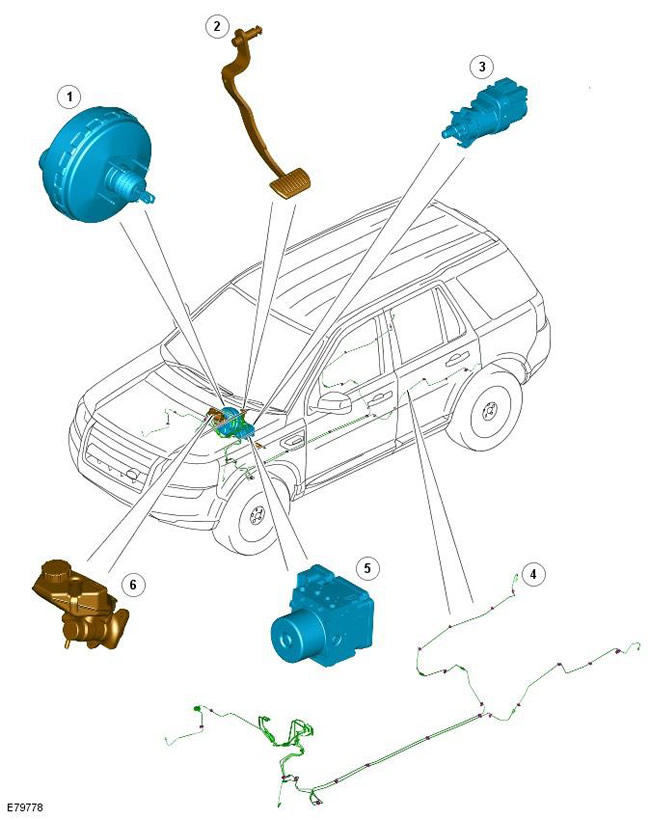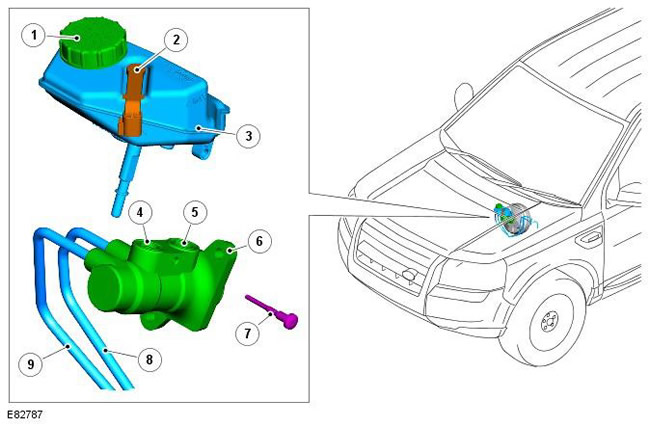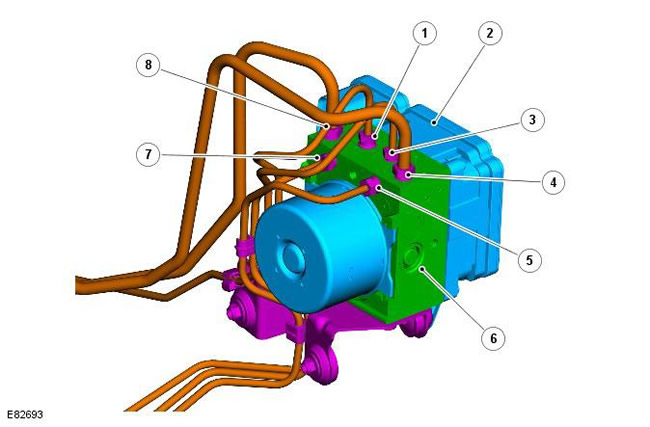Location of elements
NOTE: Left hand drive shown, right hand drive similar.

| Pos. | spare part no | Name |
| 1 | - | Vacuum brake booster |
| 2 | - | Brake pedal |
| 3 | - | Stoplight switch |
| 4 | - | Hydraulic pipelines |
| 5 | - | Hydraulic control box (HCU) complete with anti-lock braking system module (ABS) |
| 6 | - | Master brake cylinder and hydraulic brake reservoir |
The hydraulic brake actuator is diagonally split and includes the brake pedal, brake master cylinder, HCU and hydraulic lines and hoses. The system is also characterized by the presence of an inactive vacuum brake booster.
Rigid brake lines supply pressure from the master cylinder to the four brake calipers through the HCU in the block with the ABS module. Flexible hoses connect rigid brake lines to the front and rear calipers.
Brake pedal

| Pos. | spare part no | Name |
| 1 | - | Stoplight switch |
The brake pedal is attached to a bracket mounted at the rear of the bulkhead of the engine compartment. On left-hand and right-hand drive versions, the pedal assembly has a different design. It is connected to the pusher of the vacuum brake booster by means of a pin.
The brake light switch is mounted on the brake pedal bracket and activates the vehicle's brake lights when the brake pedal is depressed. The brake light switch also serves as a source of information to the cruise control system and overrides the speed selected in the system when the brake pedal is pressed. For more information, see the chapter:
- Speed Control - 3.2L (310-03 Speed Control - 3.2L, Description and function)
- Speed Control - 2.2L Diesel (310-03 Speed Control - 2.2L Diesel, Description and function)
Master brake cylinder and hydraulic brake reservoir

| Pos. | spare part no | Name |
| 1 | - | Brake reservoir cap |
| 2 | - | Brake Fluid Level Switch |
| 3 | - | Hydraulic brake reservoir |
| 4 | - | Inlet port of the secondary circuit |
| 5 | - | Primary Inlet Port |
| 6 | - | Master brake cylinder |
| 7 | - | Screw |
| 8 | - | Outlet port of the primary circuit |
| 9 | - | Outlet port of the secondary circuit |
The brake master cylinder is attached to the front of the brake booster on the driver's side in the engine compartment. The brake master cylinder has a tandem design and supplies pressure to two independent hydraulic circuits (primary and secondary). Each circuit is located between the calipers of diagonally opposite front and rear wheels, forming a fail-safe system.
The reservoir is located in the upper part of the brake master cylinder, it contains hydraulic fluid, the volume of which is sufficient for the normal operation of the system and to replenish the system in order to compensate for the wear of the brake linings. The reservoir is internally separated for independent fluid supply to each brake circuit and prevents both the primary and secondary brake circuits from shutting down simultaneously due to a single fluid leak. If a fault occurs in one hydraulic circuit, the other circuit continues to work effectively, although the brake pedal travel and the vehicle's stopping distance are increased.
On manual transmission vehicles, the brake fluid reservoir also supplies hydraulic fluid to operate the clutch.
Brake Fluid Level Switch

| Pos. | spare part no | Name |
| 1 | - | contact holder |
| 2 | - | Contact |
| 3 | - | Float |
The reservoir contains a brake fluid level sensor wired to the CJB (central electrical box). When the liquid level in the tank drops to a predetermined low level, the contacts close and send a feedback signal to the CJB. The CJB then transmits a message on the medium speed CAN bus to the instrument panel, which illuminates the red brake fluid warning light. For more information, see the chapter: Instrument Cluster (413-01 Instrument Cluster, Description and operation).
Hydraulic control box

| Pos. | spare part no | Name |
| 1 | - | Brake line to left front caliper |
| 2 | - | ABS module |
| 3 | - | Brake line to right front caliper |
| 4 | - | Brake Master Cylinder Primary Connection |
| 5 | - | Brake line to left rear caliper |
| 6 | - | HCU |
| 7 | - | Brake line to right rear caliper |
| 8 | - | Connection of the secondary circuit of the main brake cylinder |
The HCU is located on the rear left side of the engine compartment and is integrated into a single unit with the ABS module. The HCU is a 4-channel unit that modulates the hydraulic pressure supply to the brakes under the control of the ABS module.
The primary and secondary exhaust ports of the master cylinder are connected via 8mm brake lines to the primary and secondary circuits of the HCU. The primary circuit in the HCU has two separate exhaust ports routed to the right front and left rear brakes. The secondary circuit in the HCU has two separate exhaust ports routed to the left front and right rear brakes.
The HCU has three brake modes:
- Normal braking/Electronic brake force distribution (EBD)
- Braking with ABS
- Active braking
Since the HCU and the ABS module are a fully integrated unit, details regarding the design and operation of the HCU and ABS and their functionality, including the three braking modes, are given in this manual in the section titled "Anti-Lock Braking System - Stability Control". For more information, see the chapter: Anti-Lock Control - Stability Assist (206-09 Anti-Lock Control - Stability Assist, Description and function).
Service Information
The ABS module and the HCU form one unit and must not be separated. The ABS module and HCU are shipped as a single, pre-charged unit. Once installed, the hydraulic brake system only needs to be bled normally, no pressure bleed is required.
NOTE: The ABS module/HCU assembly is fragile and should be discarded if dropped or damaged.
Comments on this article